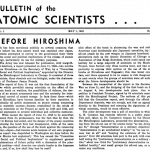Mind and habitat: Nuclear and climate threats, and the possibility of hope
By Robert Jay Lifton | April 16, 2014

Though closely related, nuclear and climate threats have mostly been treated as separate entities. I, for example, have been immersed for more than a half century in psychological and historical aspects of nuclear weapons, but only during the last year or so have I begun a similar immersion in climate dangers. Why have people like me so neglected the climate dimension?
One reason for that neglect is suggested by the ancient saying quoted to me by survivors of the atomic bomb in Hiroshima: “The state may collapse, but the mountains and rivers remain.” Those survivors of a destroyed city were relying on nature as the ultimate fallback, as a permanent entity that would continue to exist, no matter what we human beings perpetrated. That sense of eternal nature seems to be present in the folklore and symbol-systems of all cultures. Nature is perceived as the source of everything: of our minds no less than our bodies, of what we call “human nature.” The idea that this primal source of everything can itself become vulnerable to our behavior is shocking to the point of being almost unimaginable.
Yet Hiroshima survivors were by no means certain about the permanence of the mountains and rivers. There were many rumors that spread through Hiroshima immediately after the bomb, including the rumor that all those exposed to the weapon would be dead within a few years. But the most persistent rumor, described to me with great emotion, was that trees, grass, and flowers would never again grow in Hiroshima; from that day on, the city would be unable to sustain vegetation of any kind. The fear was that nature would dry up altogether; life was being extinguished at its source. I understood this to suggest an ultimate form of desolation, which not only encompassed human death but went beyond it.
Mind and habitat must be our concerns. Mind is the source of our perceptions, politics, and technologies, our instrument for coping with threat and potentially transcending it. Habitat is our dwelling place, our geographical and psychological home, the place or places that help sustain our lives. Whether that habitat is rural or urban, or even transitory, it anchors us to our planet, becomes part of “nature” in its broader, life-giving sense.
It turns out that I had, in the early seventies, connected nuclear and environmental threats in a paper I called, “Hiroshima and the Ultimate Pollution.” In that paper, I spoke of those Hiroshima rumors and also of “poison, deterioration, degeneration, and starvation” in that city, and I associated Hiroshima with the danger of destroying “the life of our own species and all other species, animal and plant.” That is, I’d written of what a number of people were beginning to call “ecocide” or the destruction of nature itself. In comparison with other terms we were using in the antinuclear movement—omnicide or human extinction, or simply a “nuclear end”—ecocide was undoubtedly the most encompassing. Yet in subsequent years, I failed to explore more extensively the connection between Hiroshima and ecocide—until that connection became impossible to ignore.
Nuclear and environmental threats: Inseparable entities? There is a sense in which nuclear and environmental threats can be considered historically inseparable. No one I met in Hiroshima was more dedicated to peace than Earle Reynolds, who had his yacht Phoenix commissioned in that city and then sailed with his family in 1958 into both American and Soviet nuclear test zones. Those voyages became legendary models for the leading environmental organization Greenpeace in its direct actions at sea on behalf of opposing nuclear weapons and preserving the human habitat. Reynolds had originally been sent to Hiroshima as part of the Atomic Bomb Casualty Commission, then a controversial American group studying delayed radiation effects in bomb survivors. He eventually left the commission because he believed it to be influenced by American political policy in minimizing the effects of the bomb, a suspicion later substantiated by a scholarly study. Reynolds and Greenpeace, one might say, were offspring of the Hiroshima bombing.
Beyond that, Joseph Masco and others have shown that nuclear testing, from the beginning, has been a form of experimentation: a way of learning about the effects of the weapons on vegetation and oceans, on our natural environment. Masco called this “militarizing nature.” And over the course of the Cold War, as Jacob Darwin Hamblin has described, the superpowers projected that they might use hydrogen bombs to trigger earthquakes, melt the Arctic icecaps, produce deadly epidemics—that is, they held increasingly radical visions of manipulating and destroying nature, all in the service of power over one’s adversary.
Nuclear and climate threats merge in connection with two features of the weapons, radiation effects and the capacity to produce a nuclear winter. Because of radiation, the ultimate novelistic and filmic portrayal of a nuclear end (in On the Beach) is also an environmental end: The human habitat is poisoned to the extent of killing everyone. Similarly, the idea of a nuclear winter suggests an explosion of sufficient megatonnage to produce a habitat so dominated by debris that the sun’s rays are blocked and the earth’s temperature lowered to the point at which human life can no longer be sustained.
No wonder that nuclear and climate threats can merge in the human mind as a common final pathway to the destruction of our habitat. Indeed, research Charles Strozier and I did in the early 1990s, just at the end of the Cold War, revealed precisely that merging. People we interviewed often moved freely in their associations, even in the same sentence, between grotesque scenes of nuclear explosions on the one hand, and on the other, projections of such environmental issues as ozone layer depletion, the greenhouse effect, and all-consuming “pollution.” Over the course of the interviews, environmental fear seemed to become more manifest and nuclear fear less so, but our overall impression was that the two were blending in what I have called imagery of extinction, with that extinction coming to include our species and our habitat.
This shift from nuclear to environmental fear has been widely recognized and noted to have a strongly generational component. But our research suggests that nuclear fear has hardly disappeared, even if it is mostly outside of awareness, and can be reactivated by historical events readily associated with it: for instance, the struggles over Iran’s nuclear reactors and potential nuclear weapons, or the meltdown of three nuclear reactors at Fukushima. It is likely that combinations of nuclear and environmental fear of catastrophe can be evoked in large numbers of people throughout the world by stimuli that are all too frequent in our era.
Different mental struggles. Yet there can be separate and different responses to the two threats. Nuclear weapons fit much more readily into apocalyptic narratives. Such narratives in the Book of Revelation and in parts of the Old Testament depict the violent destruction of the human world, to cleanse it of evil and bring about a new spiritual beginning. Many Hiroshima survivors told me of their immediate feeling that “the world is ending,” or as one put it, of “the collapse of the earth that would take place at the end of the world, which I had read about as a child.” And in general American discourse, nuclear holocaust becomes quickly associated with the all-consuming destruction of the apocalyptic narrative—so much so that for some biblical literalists, nuclear war is desirable because it will serve as the world destroyer that can bring about the spiritual renewal promised in that narrative. And since the apocalyptic narrative is so pervasive, and in some measure inhabits all of us, my suspicion is that even for the most secular among us there is a certain inclination toward imagining, however wishfully, a post-nuclear spiritual renewal.
We have more difficulty associating climate change with the extreme violence of the apocalyptic story or with a new spiritual beginning. While climate change could be no less catastrophic for ourselves and our habitat, its world destruction would not be a function of a few instruments of genocide (as in the case of nuclear weapons) so much as a continuation of the industrial development characterizing much of modern history and incorporated into worldwide cultural routine. Hence the recent characterizations of climate change as “rolling apocalypse,” “slow-motion apocalypse,” “unfolding apocalypse,” and “apocalypse of the ordinary.” The mind has a very different task in coming to terms with an apocalypse built into our routine than one caused by the use of sinister, all-destructive objects. It can more readily resort to psychic numbing, the inability or disinclination to feel. This remains true even with our increasing knowledge of the urgent danger of climate change.
With climate threat, the profound gap between knowledge and action is often attributed to what is called cognitive dissonance, the mind’s tendency to reconstruct and alter events in the world to render them consistent with its own prior convictions. But I would suggest that underneath that cognitive dissonance is a deeper anxiety having to do with nature’s ultimate claim on our minds. As human beings concerned with origins and endings, we sense that we emerge from nature and return to it in one way or another after we die. We find it enormously difficult, and completely unprecedented, to give up the idea that nature is our ultimate home. Without that natural home, we experience ourselves as floating and lacking a sense of grounding for ourselves and our cultural institutions. It is as if Hiroshima survivors’ fear that nature would dry up in their city has been extended to the rest of the world. In Hiroshima, that fear followed upon an extreme catastrophe and could be assuaged by the return of vegetation, notably cherry blossoms, in subsequent months. In contrast, climate change over the course of this century could result in actual decimation of vegetation, not in the wake of a single catastrophic event but from the creeping poisoning of atmosphere and oceans, and with less overt psychological clarity about cause and effect.
Scientists: prophetic survivors or agents of numbing. Psychic numbing is a widespread reaction to both nuclear and climate threats. In both cases, scientists have played a crucial part in helping American society in its struggles to emerge from numbing and confront the actuality of our danger. But in each case there have been other scientists who have done the opposite, made use of their authority to negate the danger and to extend and deepen the numbing. The course taken by scientists has depended greatly upon psychological and political issues having to do with mind and technology.
In the case of nuclear scientists, an important coterie drew wisdom from their own “survival” of the instrument they had created. Many of those who witnessed the test explosion at Alamogordo in July 1945 experienced the kind of awe consistent with what could be called a conversion in the desert. For quite a few, that conversion began a lifelong commitment to warning the world about the destructive power of the instrument they had created and to achieving international arrangements for preventing the weapons from ever being used again. This became what can be called their “survivor mission.” Other scientists reacted similarly to what happened in Hiroshima. Hans Bethe, for instance, told me of being “really horrified” by photographs he was shown of Hiroshima and of the “awful impression” these photographs made on him and others. And Philip Morrison, who was sent to Hiroshima to evaluate the bombing, contrasted people making decisions about atomic bombings from a distance with getting close to the weapon’s effects: “When you go there, you saw what it was like.”
There were also scientists who could imagine what the bomb would do to human beings and draw survivor wisdom from a potential event that had not yet occurred. Eugene Rabinowitch, for instance, wrote of an experience during the summer of 1945, when walking through the streets of Chicago and “vividly imagining the sky suddenly lit up by a giant fireball, the steel skeletons of skyscrapers bending into grotesque shapes … until a great cloud of dust rose and settled into the crumbling city.” That survivor-like experience motivated him to work with other Manhattan Project veterans such as Leo Szilard and James Franck in efforts to prevent the use of the weapon on an inhabited city. Joseph Rotblat brought similar prospective imagination to his decision to leave the Los Alamos project upon learning that Germany had failed to create an atomic bomb and that the weapon might be used for political purposes.
But there were others whose conversion-like experience was of an opposite kind: the embrace of the bomb itself as the source of ultimate power and advanced scientific and technological achievement. This psychological state of nuclearism was best exemplified by Edward Teller. He decried what he called “a monstrous anxiety” concerning fear of nuclear annihilation, and his version of the legacy of Hiroshima was to insist that “we cannot and must not try to limit the use of weapons.” A similar position was taken by Herman Kahn, trained as a physicist but more prominent as a nuclear strategist. Kahn’s message was that nuclear war was not only survivable but winnable. It was Kahn who advocated radiation meters for everyone, so that a man who became sick could be told, “You’ve only received ten roentgens, why are you vomiting? Pull yourself together and get to work.”
The nuclearism of Teller, Kahn, and others involved denying, minimizing, distorting, and sometimes falsifying the lethal nature of nuclear weapons. Members of the antinuclear scientists movement have constantly sought to combat those tendencies, and there has been a vast in-between among scientists who have partially embraced the weapons for reasons of “deterrence,” or held to a principle of “living with nuclear weapons” and seeking to avoid their use. But nuclearists like Teller and Kahn have had periods of enormous political and psychological influence in promoting dangerously belligerent policies, and in enhancing widespread patterns of psychic numbing that inhibit actions to reduce nuclear danger.
In relation to climate, scientists have had an equally striking and even more pivotal role. It is they who have expressed warnings of extreme danger, which have required them to carry out the daunting task of imagining and “surviving” what they consider likely developments of the future. They have had to mobilize the mathematics of their science on behalf of warnings both dire and virtual. Rarely has science assumed so prophetic a function, and one so necessary, on the basis of anticipated events. Yet it must be added that these prospective findings have a strong basis in immediate evidence, in observations of climate change that has already occurred and continues to occur at dangerous levels.
No wonder that the prophetic scientists of climate change have had difficulty in finding general acceptance of their deeply troubling findings. Or that a tiny number of scientific “denialists”—more accurately, falsifiers—of climate findings have had an inordinate influence by making contact with prominent politicians inclined toward similar attitudes. Such scientists may share with these politicians deep antagonism toward governmental restrictions and government in general, along with insistence upon absolute entrepreneurial freedom. They have been cavalier in their treatment of evidence, funded lavishly by the large international oil corporations, and have at times created the illusion that there was a genuine scientific controversy about the issue. (The scope of the problem is suggested by some of the expressed views of Freeman Dyson, who is neither right-wing nor funded by oil companies, and in fact one of the great scientific minds of our era. He and others emphasize his “contrarian tendencies” and “scientific skepticism,” but one has the impression that his downplaying of the climate threat has to do with his faith in the power of technoscience to master nature, to modify and control our habitat, and in that way assert our adaptability as a species.)
Continuities in scientific distortion. There are striking continuities in the behavior of scientists who negate nuclear and climate threat. Here again a key figure is Edward Teller. Teller’s nuclearism included not only an uncritical embrace of the hydrogen bomb and its potential use but a strangely absurd negation of the effects of radiation. Although a brilliant scientist, he could in 1962 write: “Radiation from test fallout may be slightly harmful to humans, it may be slightly beneficial, it may have no effect at all.” Thirty-six years later he made a parallel statement about carbon in the atmosphere: “Society’s emissions of carbon dioxide may or may not turn out to have something significant to do with global warming. The jury is still out.” Teller also took public stands against the Kyoto protocol and other efforts to limit carbon emissions and came to advocate a form of geoengineering, of infusing the atmosphere with dust particles that would block the sun’s rays sufficiently to prevent climate change.
Teller was a dominant figure in the formation of the George C. Marshall Institute, which was initially concerned with promoting the cause of nuclearism by opposing arms control, advocating for the Strategic Defense Initiative (in which anti-ballistic missiles would be used to counter nuclear weapons in a way that most scientists and strategists felt would destabilize whatever nuclear equilibrium existed), and generally opposing the antinuclear positions of such groups as the Union of Concerned Scientists and the Federation of American Scientists.
The same Marshall Institute was to issue statements denying the danger of the destruction of the ozone layer and also secondhand smoke. Then, in 1989, a Marshall Institute report attacked the “alarmists” of climate change and attributed whatever climate change might be occurring to the rays of the sun. As historians Naomi Oreskes and Erik Conway have pointed out, the Marshall Institute had considerable influence in the George W. Bush White House, so much so that, in 2007, Vice President Richard Cheney could claim that there was no consensus on whether or not climate change was “part of the normal cycle versus the extent to which it’s caused by man, greenhouse gases, etc.”
Perhaps this sequence from nuclearism to climate science falsification should not surprise us. In both there is a negation of the harmful effects of technologies acting upon our habitat, along with a form of scientism that sees an always-available technoscientific fix for problems that arise. This mind-technology illusion connects readily with a political context of a fierce crusade against not only Communism (and other political enemies) but also against the kind of liberalism that would diminish the number and centrality of nuclear weapons and place restraints upon industries that spew carbon into the atmosphere. Nuclearism and climate distortion, then, become doctrines of a national security state, or what I have called “superpower syndrome,” which includes a sense of national omnipotence along with an illusory quest for absolute security. Scientists are not immune from these political and emotional excesses, and their involvement in the national security state and the superpower syndrome can do much to determine how they practice (or mispractice) their science, evaluate evidence, and lend themselves to dangerous technological miscalculations.
But responsible science has its continuities as well, and is a major source of hope.
A climate “swerve”? Hope is hard to maintain among those who seriously engage climate change. The actualities are daunting and preventive actions have been feeble. People sometimes ask me, a psychiatrist, how to address this debilitating hopelessness. I have no psychiatric magic to offer but I believe that there are certain significant directions of possibility.
The first thing to note is that something important is happening in relationship to climate awareness. In general, we are quite ignorant about how large changes in consciousness come about. The subject has always been elusive and is rendered more so by the information revolution in our time. Still, we may well be entering a significant “swerve” in climate change consciousness. That word was used by the first century BCE Roman poet and philosopher Lucretius to describe unpredictable and unexpected movement of matter and has recently been appropriated by the humanist Stephen Greenblatt to describe an equally unpredictable historical shift, notably the emergence of modernity as influenced by Lucretius himself.
We came close to such a swerve in nuclear weapons consciousness during the early 1980s. I could witness some of that shift as a participant in the physicians’ antinuclear movement. This medical effort shared a certain continuity with the earlier physicists’ movement in making use of scientific evidence and projections from that evidence to bring about a change in public awareness of the weapons and their dangers. Indeed, I was working in Hiroshima in 1962 when I first read about the early expression of this movement: doctors in Boston projecting the details of destruction, and the absence of functional medical facilities, that would result from the dropping of a 5-megaton nuclear weapon at a particular point, Watertown Square, in their city. As the movement became international, our message was the same for other cities in the Western hemisphere, Europe, and other parts of the world. I mention this not to claim that nuclear danger has been eliminated—far from it—though it is possible that the change in consciousness helped prevent the use of the weapons. My point here is that dramatic shifts in consciousness of catastrophic danger, now more than ever, can occur suddenly and unexpectedly.
Scientists have already done much to facilitate such a change. Consider the imaginative achievement of bringing about a movement on the basis of mathematics: the 350.org organization, under the leadership of Bill McKibben, emerging from the findings of climate scientist James Hansen to the effect that such a number was a danger point in terms of particles of carbon per million in the atmosphere. To be sure, climate change doesn’t readily produce images equivalent to those that physicists and physicians could call forth in connection with nuclear destruction. But we are beginning to get a glimmer of powerful climate images: areas near or below sea level (Bangladesh, Pacific Islands) inundated by water and nearly going under; and closer-to-home pictures of Alaskan villagers, America’s first climate refugees; New Orleans; a flooded New York subway system; and severe damage to the US Northeast Atlantic coastline from Hurricane Sandy.
More than that, we have the impression of climate stories appearing every day, whether about floods in England, droughts in California, severe storms in the American Midwest, or typhoons in the Philippines. Whatever the uncertainty about cause and effect, and the obfuscation on the part of deniers, these events are having a profound impact on our psyches.
Indeed, we do well to recognize a quantum leap of fearful awareness of climate change. Suppressed nuclear fear can contribute to this sense of catastrophic danger. And the awareness can only increase for one irrefutable reason: Climate change, more than any other issue, is all-encompassing. Even more than nuclear weapons, climate danger envelops our entire planet. No person or group can be free of it. Pragmatic institutions, such as the military and insurance companies, have been longtime students of climate change. And large corporations, such as Coca Cola, have realized how much their business can be threatened by it. Even those who have most vehemently, and harmfully, denied climate change, and financed others to do so, have to be fearful of precisely what they have denied. The oil conglomerates have been slowing down in their contributions to denial and worrying about how they themselves will be affected. A world whose atmosphere has been poisoned by carbon means bad business—even for ExxonMobil.
Of course this climate change swerve in no way eliminates the formidable political, psychological, and technical issues that confront us. But it could help us to mobilize our intellectual capacities and moral passions on behalf of our threatened habitat. In doing so we would be giving new expression to the notable human capacity for resilience and adaption and could thereby experience a sense of hope, in ourselves and for our species.
Editor’s note: The author is grateful for grants from the Gould Family Foundation and from Carolyn Mugar.
Together, we make the world safer.
The Bulletin elevates expert voices above the noise. But as an independent nonprofit organization, our operations depend on the support of readers like you. Help us continue to deliver quality journalism that holds leaders accountable. Your support of our work at any level is important. In return, we promise our coverage will be understandable, influential, vigilant, solution-oriented, and fair-minded. Together we can make a difference.
Share: [addthis tool="addthis_inline_share_toolbox"]














